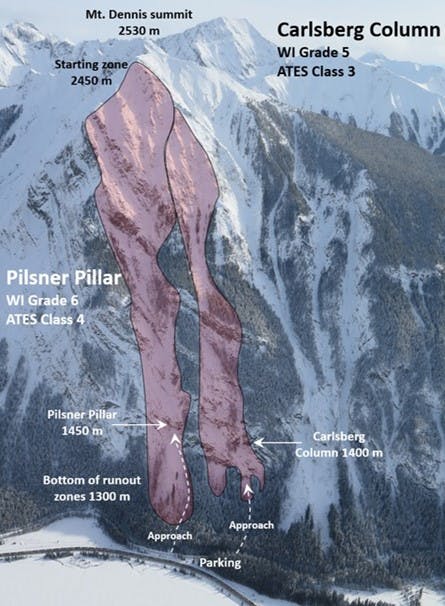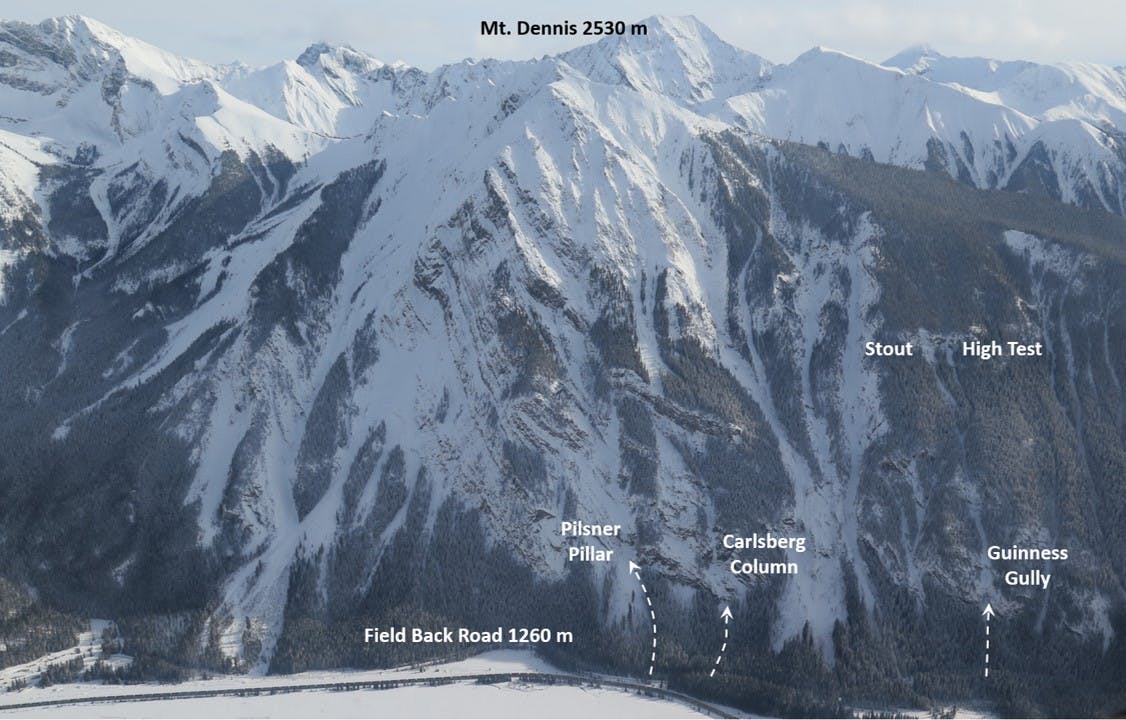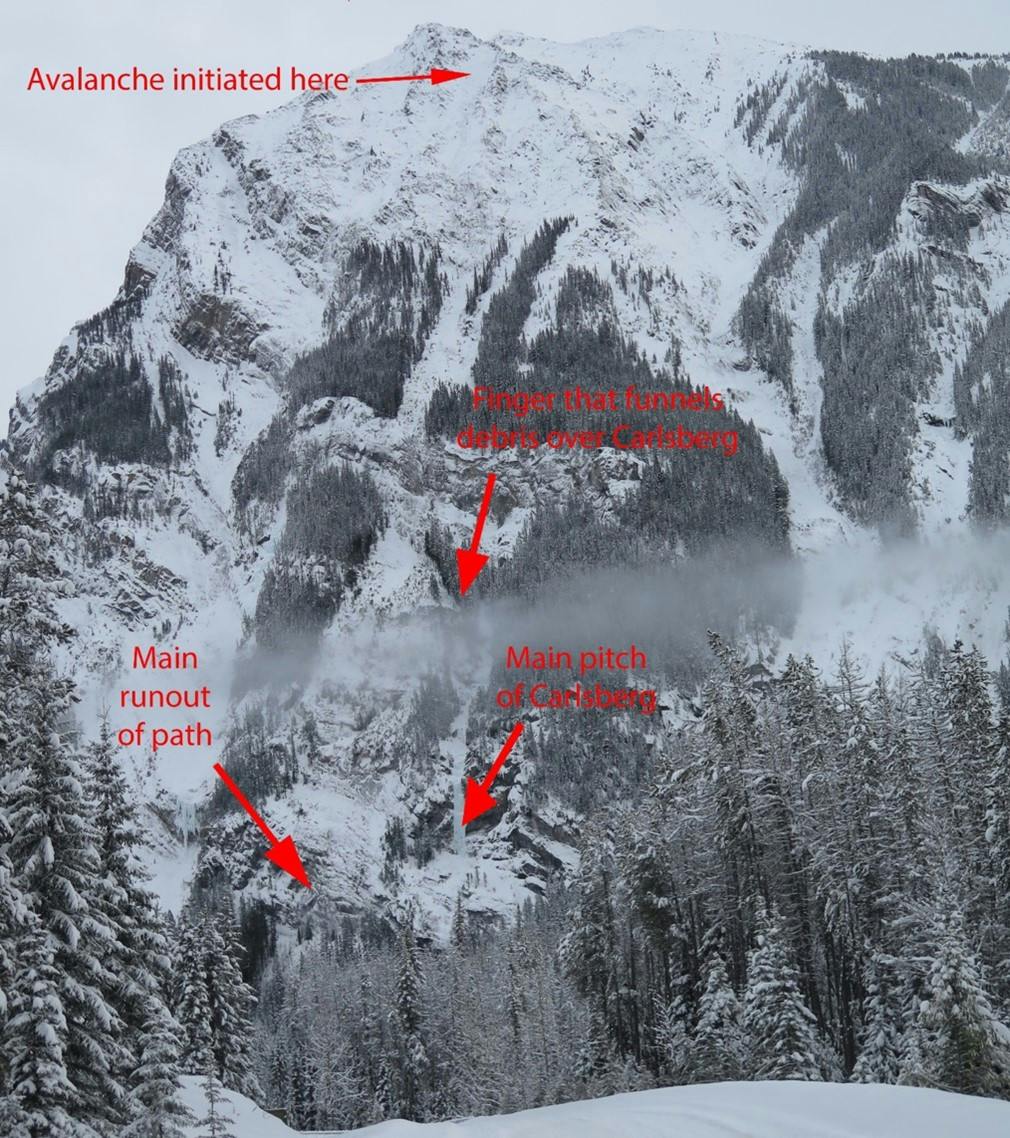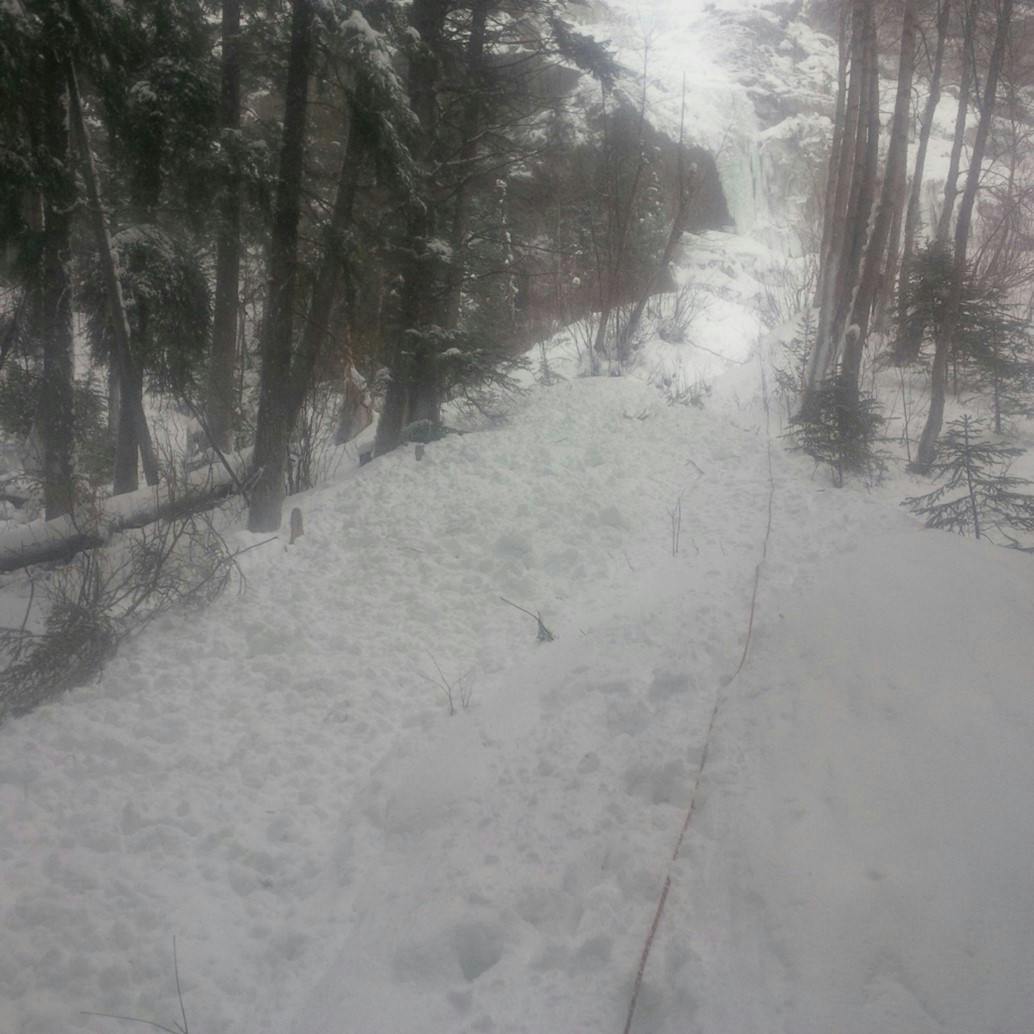
Carlsberg is a beautiful and classic Grade 5 curtain that sits in the middle of the beer climbs on Mt Dennis. It has a two-pitch approach to the main curtain or an exposed “walk/scramble” around to climbers right. After this approach, Carlsberg is on the left and Cascade Kronenbourg, which forms sporadically, hangs on the right (as well as some mixed lines during leaner years). The main curtain itself is usually climbed in 2 pitches with bolted belays, but can be climbed in 1 long pitch. Sometimes a short, steep bonus pitch exists a short way up on climbers right; this is not impacted by avalanche terrain.
Avalanche Control on Mt. Dennis
The Field Back Road beneath Mt. Dennis is an Intermittent Avalanche Closure Zone. Parks Canada does avalanche control to protect the road and the CP Rail line and this means that the road and the climbs will be closed periodically throughout the winter for explosives avalanche control. It is illegal to breach these closures.
Parks Canada posts notifications of closures the day before in the headline of the avalanche forecast. The gates will be closed at both ends of the Field Back Road and signs will indicate the closure. This avalanche control is to protect the road and rail routes, it does not protect the ice climbs. There are many times when natural or human triggered avalanches could run over the climbs, but would not reach the transport routes meaning no avalanche control will be carried out.

Popularity
22 people completed this survey.
- 64% climbed Carlsberg 1 – 5 times
- 18% climbed it 6 – 10 times
- 18% climbed it over 10 times
Avalanche Frequency
- 24% have seen debris on the approach to the climb
- 57% have seen debris at the base of the climbs
- 5% have seen debris above the top pitch
- 30% have witnessed avalanches
Time of Year and Day
The most common time for ascents and the witnessing avalanche debris was February- April, with December to January being most common and October to November being the least common.
- 50% of avalanches were witnessed between 6:00 am – 12:00 pm
- 50% of avalanches were witnessed between 12:00 pm – 6:00 pm
Avalanche Start Zones
- 43% believe the observed avalanche started well above the climb
- 27% believe the observed avalanche started right above the climb
- 14% believe the avalanche they witnessed was human triggered
- 14% were not sure on the start zone or cause of the observed avalanche
Notes on Avalanche Debris
- Debris can run full path to the trees well below the first pitch, often in the spring
- Debris has been witnessed right below the first pitch
- Debris has been witnessed between the first pitches and the crux curtain
Reported Avalanches and Incidents
- An avalanche was reported by one climber while leading the crux pitch on Jan 25 2018
- Avalanches have run over the climbs during explosive avalanche control from a helicopter
- On a cold, sunny morning in mid-March, there was an avalanche observed on Pilsner and the gully immediately climbers’ left of Carlsberg. It ran full path. This avalanche was likely caused by warming during an inversion, but wind may have also been a factor. The group that witnessed this was at a belay on the left side of the top of the climb and the debris flow was 10-15m away
- Other avalanches were witnessed in the gully to the left of the climb, in the trees above the route, and in the cut block while hiking up
Incident Case Study

On the day of the avalanche, the forecast was moderate for all elevations and there was 10 – 15 cm of fresh snow. The Mount Dennis climbs had seen avalanche control from Parks Canada with good results a week prior.
As the party was climbing the approach pitches, a storm began with 3 – 4 cm of snow per hour and moderate to strong winds. On the first pitch of the steep curtain, the party experienced the avalanche. The climber heard a rumble and saw a huge powder cloud pouring over the avalanche path to his left. Next, he heard a rumble above him but the snow was soft and most of it went over his head. It lasted for 20 – 30 seconds. He belayer had tucked into the wall and wasn’t buried, although he had difficulty breathing.
The avalanche that ran over them was a small part of a size 2.5 that started in the alpine and mostly ran in the gully to the climbers’ left of Carlsberg. The main avalanche ran full path into the trees below and the part that ran over the climbers, ran to below the first pitch. It deposited enough snow to bury someone in the gully below the first pitch.
The storm created a natural cycle in Field, with natural avalanches running over Super Bok, Extra Lite, Heineken Hall, Dennis 1, and Carlsberg.

Contributing factors in order of significance
- 57% felt warming and solar radiation had contributed to the witnessed avalanche
- 43% felt new snow amounts had contributed to the witnessed avalanche
- 43% felt winds had contributed to the witnessed avalanche
Summary
The main avalanche concern for Carlsberg comes from a small finger of a larger path that runs between Pilsner and Carlsberg. The finger can produce avalanches large enough to affect the climb and bury someone at the base. The path that affects Carlsberg is controlled by Parks Canada as it impacts the road, but it is possible for it to avalanche naturally too.
The walk around of the approach pitches (which is more like an exposed scramble) may keep climbers out of more exposed avalanche terrain, but has the potential for a human triggered avalanche. It has enough exposure that falls from there have proven fatal in the past.
Additional notes from the community
Many people view Carlsberg as one of the safer climbs in Field. Although it may be somewhat protected from avalanches that initiate at ridge crest, there is still a risk that a large avalanche from the start zone can produce a dangerous avalanche in the gully that goes over the climb.
Due to its proximity to the road, one could eliminate extra time in the terrain by getting fully prepped at the car.